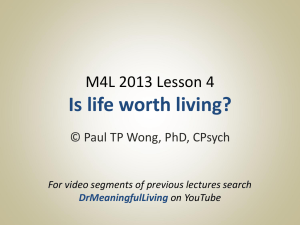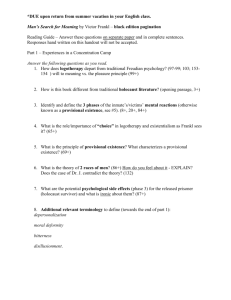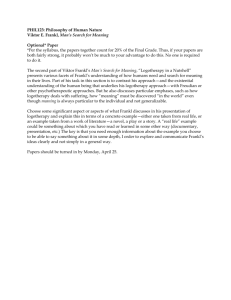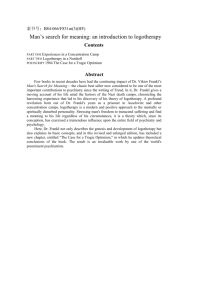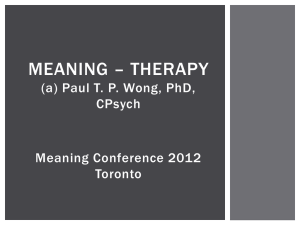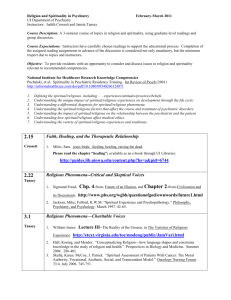What is Meaning Therapy?
advertisement
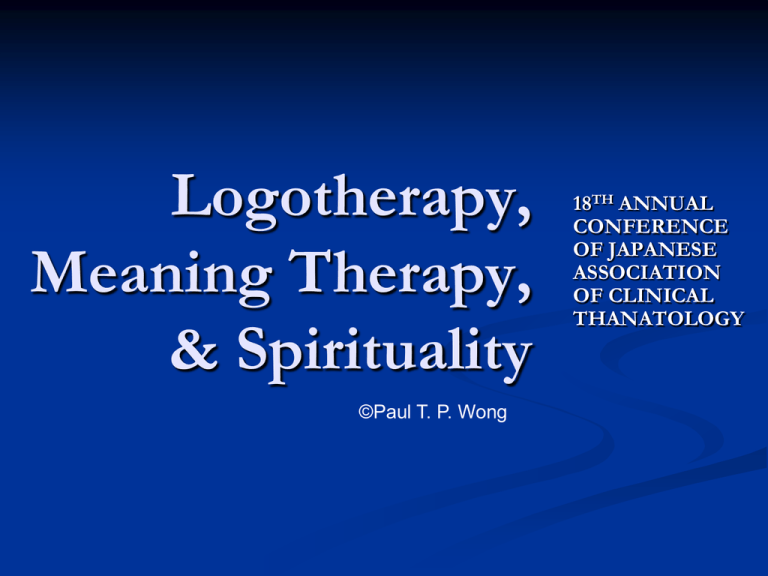
Logotherapy, Meaning Therapy, & Spirituality ©Paul T. P. Wong 18TH ANNUAL CONFERENCE OF JAPANESE ASSOCIATION OF CLINICAL THANATOLOGY Overview The role of meaning in spiritual care for cancer patients Dr. Frankl’s Logotherapy & his concept of spirituality Wong’s Meaning Therapy in tapping into the human capacity for meaning making Breitbart’s Meaning-Centered Group Therapy for Cancer Patients Session 1 – Concepts of meaning and sources of meaning Session 2 – Cancer and meaning Session 3 – Meaning and historical context of life Session 4 – Storytelling, life project Session 5 – Limitations and finiteness of life Session 6 – Responsibility, creativity, deeds Session 7 – Experience, nature, art, humor Session 8 – Termination, goodbyes, hopes for the future Itami’s Meaningful Living Therapy with Cancer Patients Reynolds (1989) - The basic principles for the patient of M.L.T. are: 1. To take major responsibility in the fight against the disease. 2. To live a life devoted to fulfilling daily goals. 3. To be helpful to others. 4. To undergo training in coping with the anxiety associated with illness and the fear of death. 5. To contend with death naturally and constructively by accepting the principle that everyone inevitably dies. 6. To avoid being a "sick person" even though ill. 7. To live out the remainder of life positively, undefeated by the disease. Katsutaro Nagata WHO professor, psychosomatic medicine and psychopharmacology Logotherapy approach to pain & illness Logotherapy as effective treatment for chronic pain Dimensions of Suffering (Mak, 2007) Physical – physical symptoms & pain Psychological – helplessness, hopelessness, & uncertainty Social – isolation & relational conflict Spiritual – lack of meaning in life The Good Death A comfortable & pain-free death A harmonious death A meaningful death A hopeful death A peaceful death Aspects of Spirituality Pertain to ultimate meaning and purpose Discover a sense of meaning, calling, & significance Involve certain spiritual practices May involve a set of religious beliefs & rituals Believe in a Higher Being and a spiritual reality Experience sacred moments Cultivate a transcendental connection Seek spiritual direction & formation An Instrument Approach to Spiritual Care: (Based on what you say and do with patients) Addressing patients’ spiritual needs Addressing patients’ existential needs Taking a spiritual history of patients Incorporating appropriate spiritual practices Involving chaplains and spiritual leaders Involving the appropriate faith community A Transformative Approach to Spiritual Care: (Based on what you say and do with patients) The healing silence – listening to the inner voice The healing touch – touching the heart & soul The healing connection – establishing an I-You relationship The healing presence – providing a caring, compassionate presence The healing process – nurturing spiritual growth Coping with Death Anxiety Elizabeth Kubler-Ross’s (1969) five stages of coping Denial – Death avoidance and extreme sports Anger – Aggression, violence and terrorism Bargaining – Doing good deeds or worshipping gods Depression – Disengagement and isolation Acceptance –Engagement in life Three Types of Death Acceptance (Wong, Reker, & Gesser, 1994) 1. Neutral - facing death rationally as an inevitable end of every life 2. Approach - accepting death as a gateway to a better afterlife 3. Escape - choosing death as a better alternative to a painful existence Positive Death Acceptance “Death Acceptance is the only antidote to Death Anxiety.” Acceptance of one’s life as worthwhile Readiness to let go things of this world Recognition of the spiritual connection with a transcendental reality Hope in sharing spiritual life with loved ones for all eternity Pathways to Death Acceptance Life review (Wong, 1995) Self-acceptance (Wong, 1998) Religious/spiritual beliefs (Wong, 1998) Embracing one’s own life Death education To contemplate our death is to contemplate our life that leads to death. Coping with Death Anxiety The Japanese Perspective Naikan Therapy – focuses on inner looking & self-cultivation; life review of one’s relationship with a significant other, resulting in a more realistic sense of self & relationships Morita Therapy – learning to accept & live with negative emotions without judgment, focuses on taking control of own behaviour in spite of how one feels The Life-Death Connection “To solve the problem of death, one must first solve the problem of life, living life” (Dennis Yoshikawa) “To be prepared for death is to be prepared for living; to die well is to live well” (Konosuke Matsushita) “ Living well and dying well involve enhancing one’s sense of self, one’s relationships with others, and one’s understanding of the transcendent, the spiritual, the supernatural….” (Kuhl, 2002) Living and Dying well through Meaning & Spirituality • Human beings are born with the innate need for meaning & spirituality. • Finding meaning and purpose can make a big difference in how we live & how we die. • The psychology of meaning management helps deepen our spirituality and existential understanding. • Meaning management helps construct an effective psychological and spiritual model. • Meaning management motivates us to embrace & assume responsibility for our personal lives. Viktor Frankl & the Medical Ministry Logotherapy is adjunct to medical treatments. Healing needs to occur at the spiritual level. Needs to address questions of suffering and death Meaning can be found in the most horrible situations. Needs to awaken the defiant human spirit For more information, visit www.meaning.ca What is Logotherapy? Logotherapy literally means therapy through meaning. It is a spiritually-oriented approach towards psychotherapy. Existential analysis is needed to make the clients aware of their spirituality and capacity for meaning. “Inasmuch as logotherapy makes him aware of the hidden logos of his existence, it is an analytical process” (Frankl, 1984, p. 125). Existential Vacuum Many people seek healing of inner emptiness because of a felt sense of existential vacuum. Frankl believed that existential vacuum may lead to both the tragic triad and neurotic triad. Meaning therapy is uniquely suitable to address these mental health issues. The Tragic Triad pain guilt death The Neurotic Triad depression aggression addiction The Basic Tenets of Logotherapy Freedom of will: Not only freedom from some negative condition but also freedom to something rewarding. Will to meaning: Striving to find a meaning in one’s life is the primary motivational force. Meaning of life: One can always discover meaning in life regardless of life’s circumstances. Freedom & Responsibility Logotherapy emphasizes the responsible & meaningful use of freedom. Human existence can only be understood in terms of responsibility. The will to meaning is based on a sense of responsibility. Responsibleness means meeting the demand quality of every situation. The Will to Meaning It is the primary motivation for living. Everyone needs to find the true meaning of one’s own life. Will to meaning is essential for resilience and well-being to the extent that it means one’s capacity to live in spite of pain & suffering (similar to the will to live, “sei no yokubo”, in Meaningful Life Therapy) Meaning of Life Life has meaning under all circumstances. It is our responsibility to respond to life’s demands. Each person must discover the meaning potential of each situation. The ultimate meaning lies in its pursuit. The situational meaning can be experienced through three avenues of value. Three Basic Pathways to Meaning Creative value: giving something to the world through creative works. Experiential value: receiving something from the world through appreciation and gratitude. Attitudinal value: taking a heroic stand towards suffering and fate. Schematic Representation of Human Dimensions l l l l l Will to Meaning Moral Understanding Spiritual Beliefs and Values Positive Attitudes in Suffering Spiritual l l Noetic l PSYCHOLOGICAL l l l l l l l Emotional States Stress Reaction Physical Pain Sensation Awareness of the Spiritual Realm Capacity to Know God Encounter with the Transcendent Perception Learning & Meaning Higher Cognitive Social Processes Psychosomatic l Biological l l PERSONHOOD Sociocultural Context Physical Health Biological Drives Biochemical Processes Noetic Dimension The dimension of the human spirit It is the healthy core or “medicine chest” of logotherapy. It contains uniquely human attributes, such as: will to meaning, ideals, creativity, faith, love, conscience, self-detachment, self-transcendence, humor, goal-striving, and taking on commitments & responsibilities. What is Meaning Therapy? It evolves from logotherapy and cognitive behavioral therapy. It is part of the third wave of psychotherapy which involves powerful new concepts such as acceptance, commitment, meaning-making, and restorying. The Defining Characteristics of Meaning Therapy Integrative/holistic Existential/spiritual Relational Positively oriented Multicultural Narrative Psycho-educational Meaning Therapy is Integrative Existential meaning – Logotherapy & Existential Therapy Cognitive meaning – Cognitive-Behavioural Therapy Narrative meaning – Narrative Therapy Positive meaning – Positive Psychotherapy Cultural meaning – Cross-cultural & Indigenous Therapy The Motto of Meaning Therapy Meaning is all we need. Relationship is all we have. It is difficult to implement effective interventions when either one of the above conditions is missing. The Therapeutic Presence Who we are is more important than what we say. Rogers’ three pre-conditions need to be the personal characteristics of counsellors. Personal wholeness of the therapist is important. The messenger is the message. The therapist is the therapy. The counsellor brings a healing presence. The counsellor models meaningful living. The counsellor practices counselling by osmosis. Healing through Relationship Building rapport and trust is essential to effective therapy. Authentic and caring relationships has more healing power than therapeutic alliance. Accepting resistance and negative reaction as part of the healing process. The ground rule of respect and caring applied to both the therapist and the client. Recognize that each individual is both unique and similar. Different Levels of Relating At the social level, two strangers get to know each other in a trusting and non-judgmental environment. At the existential level, two human beings share their common humanity. At the professional level, the therapist is responsible for achieving desirable therapeutic goals. Therapy involves the reciprocal influence between the therapist and the client. Therapeutic Goals To awaken the client’s sense of responsibility and meaning. To achieve a deeper understanding of the problem from a larger perspective. To help the client discover their true identity and place in the world. To help the client pursue what really matters in life. Therapeutic Goals Cont’d To grow and develop the client’s full potential. To make life better for self and others. To transform a victim’s journey into a hero’s adventure. To discover meaning and hope in boundary situations. To learn principles and skills to achieve positive outcomes and transform negative outcomes through meaning. The Art of Questioning Responsibility questions Choice questions Trajectory questions Quest questions Eight enduring existential questions Magic questions Diagnostic questions Eight Enduring Existential Questions 1. 2. 3. 4. 5. 6. 7. 8. Who am I? How and where do I find happiness? What should I do with my life? How can I avoid making the wrong choices in the major areas of my life? Where do I belong? What is the point of all my striving? What will happen to me after I die? What would make my life more meaningful and significant? The PURE Principles The four treasures of Meaning Therapy: Purpose – the motivational component Understanding – the cognitive component Responsible action – the behavioral component Enjoyment – the affective component The ABCDE Strategy Accept and confront the reality -- the reality principle. Believe that life is worth living – the faith principle. Commit to goals and actions – the action principle. Discover the meaning and significance of self and Evaluate the above – the self-regulation principle. situations – the Aha! principle. Acceptance Accepting what cannot be changed. Accepting reality, limitations, loss, trauma, existential givens. Acceptance does not mean giving up or resignation. Confronting one’s worst fears with courage and tragic optimism. Transcending and transforming the tragedy. Levels of Acceptance Cognitive acceptance Emotional acceptance Realistic acceptance Integrative acceptance Existential acceptance Transcendental acceptance Transformative acceptance Belief Affirming one’s ideals and core values. Believing in the intrinsic value and meaning Believing in an Ultimate Rescuer or Higher Believing in the eventual triumph of good of life Power & justice Commitment Moving forward and carrying out one’s responsibility with determination Doing what needs to be done regardless of feelings or circumstances Striving to fulfill one’s responsibility no matter what Enduring hardship and pain for a worthy cause Practicing the PURE principle Pursuing realistic goals Re-authoring one’s life story Discovery Learning something new about the self and life. Digging deeper, exploring farther, and searching higher. Discovering one’s hidden courage and strength. Discovering the power of faith and spiritual resources. Grasping the complexities of life and people. Evaluation Savoring small successes or re-assessing one’s progress. Feeling relief that the worst is over. Savoring the moments of small success. Reflecting and reviewing one’s life. Receiving feedback from others. Conducting assessments and making adjustments. SOURCES OF MEANING According to Wong (1998), there are 8 sources of meaning and the good life. 1. Achievement 5. Relationship 2. Acceptance 6. Religion 3. Transcendence 7. Fairness 4. Intimacy 8. Positive emotions Definition of a Meaningful Moment 1. It is deeply felt – It touches your emotions in a deep and lasting way. More than a fleeting feeling, it reaches your innermost being. 2. It is deeply processed – It involves deeper layers of meaning beyond the factual and superficial. 3. It is enlightening – It provides a solution to some puzzling problems or leads to some new discovery. 4. It is transforming – It enriches your life, changes your life’s direction or restores a sense of purpose and passion to your life. The Meaning Mindset 1. Life has intrinsic meaning and value. 2. My ultimate purpose is self-transcendence. 3. I can live at a deeper level by detecting the meaning & significance of any situation. 4. I can live at a higher plane by serving a higher purpose & being attuned to the transcendental realm. 5. I can live fully by integrating by my potentialities with my vulnerabilities moment by moment. Life Orientation Scale 1. 2. 3. 4. 5. 6. 7. I can find something meaningful or significant in everyday events. 1 2 3 4 5 There is a reason for everything that happens to me. 1 2 3 4 5 There is no ultimate meaning and purpose in life. 1 2 3 4 5 There is no point in searching for meaning in life. 1 2 3 4 5 No matter how painful the situation, life is still worth living. 1 2 3 4 5 The meaning of life is to “eat, drink and be happy”. 1 2 3 4 5 What really matters to me is to pursue a higher purpose or calling regardless of personal cost. 1 2 3 4 5 8. I would rather be a happy pig than a sad saint. 1 2 3 4 5 9. I am willing to sacrifice personal interests for the greater good. 12345 10.Personal happiness and success are more important to me than achieving inner goodness and moral excellence. 1 2 3 4 5 Meaning-mindset Meaningful moments PURE Framework Sources of meaning Frankl’s 3 basic tenets and values of meaning Patterns of Resilience Recovery: Bouncing back and returning to normal functioning. Invulnerability: Remaining relatively unscathed by the adversity or trauma. Post-traumatic Growth: Bouncing back and becoming stronger. Four Life Trajectories Elements of Tragic Optimism Acceptance of the worst. Affirmation of the value and meaning of life. Self-transcendence (altruism). Faith in God and others. Courage to face adversity. Conclusion Meaning is a key component in spiritual care for cancer patients. Logotherapy focuses on the responsibility to discover & fulfill the will to meaning through self-transcendence & authentic living. Meaning therapy is integrative. It focuses on the human capacity for meaning-seeking & meaning-making.
